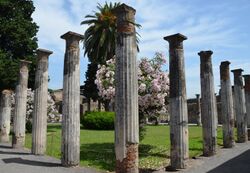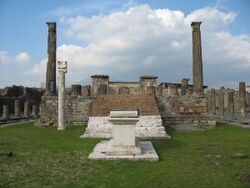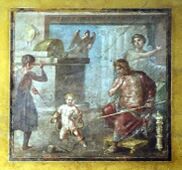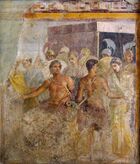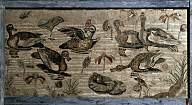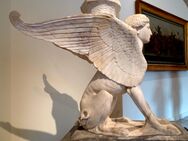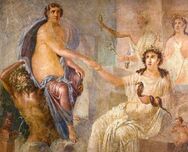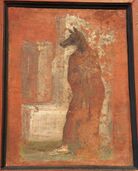- culture
- pompeii
- egypt
1. Origin of Greek Influences
The origins of Greek influences on Pompeii stems from an ancient region collectively known by the Romans as ‘Magna Graceia’: a term used to label the cities of southern Italy established by the Greeks in the eighth century BCE. The Greeks were attracted to this area due to the fertile land it offered and the advantageous trading position it controlled. As the settlement flourished, Greek influence was transmitted to Pompeii and the wider Roman world through these colonies. Rooted in this early link, Rome developed a deep and enduring fascination for Greek culture as they integrated its art, architecture and religion into their own society.[3] The popularity of Hellenic culture grew following the successful Roman capture of Syracuse (212 BCE) and sack of Corinth (146 BCE) where plundered Greek art and architecture were brought back to Rome.[4]
2. Greek Influences on Pompeii
Art
The Alexander Mosaic
The Alexander Mosaic, unearthed during an 1831 excavation of the House of the Faun, depicts a battle between Alexander the Great and Darius III of Persia alongside their respective armies. This mosaic is believed to be a copy of a famous Greek painting by Philoxenos of Eretria dated c. 300 BCE. It mirrors the elements of traditional Hellenistic art by both emphasising visual effects and drawing to attention the emotional reaction of the fighters.[5]
The Three Graces Fresco
Discovered in the House of Titus Dentatus Panthera (on south wall of tablinum), the Three Graces fresco depicts the Graces dancing naked in a circle while holding sprigs of myrtle and wearing wreaths.[6] The Graces (also known as the Charities) were minor goddesses of Greek mythology.[7]
Doryphoros
Numerous Roman copies of Doryphoros (‘Spear-Bearer’) have been found around Campania including one in Pompeii. This statue, dated 120–50 BCE and made from Carrara marble, is an imitation of the bronze Greek original by the famed sculptor Polykleitos.[8]
Architecture
Basilica
Pompeii’s Basilica (built between 120 BC and 78 BC) was constructed in the Hellenistic style. The building featured two levels of Greek Corinthian and Ionic columns rather than Roman arches to support the roof.[9] A ancient Greek stoa; a freestanding colonnade which created public spaces.[10]
Palestra
The large Palestra of Pompeii, located in the eastern periphery of the city, adopts Greek architectural elements with its large, open colonnaded spaces. This Roman practice of constructing Palestras originates from the ancient Greek gymnasium, a complex similarly built for training and exercise.[11]
Streetscapes
The streetscape of Pompeii, with its use of insulae to divide the roads of the town into blocks.[12]
Peristyle
The peristyle, based on Greek design, featured in several of Pompeii’s private buildings and villas. A peristyle was a colonnade or covered walkway around a courtyard which enclosed a garden. The House of The Faun depicts this architectural feature containing two peristyles: one built in the early 2nd century BC and the other in the late 2nd century BC.[13]
Religion
The Cult of Dionysus
Dionysus, the god of fertility and wine was worshipped by the Greeks. Romans called this god Bacchus. Associated with this cult was the ‘bacchanalia’, a Latin term for the rites or festivals of Bacchus which according to Livy involved cult members participating in aggressive sexual promiscuity and alcohol-fuelled violence. In 186 BC the Roman senate, fearing that the unbridled nature of the festivals was a threat to public and political stability, outlawed the cult. Despite this, its practice still remained popular in Campania and evidence suggests Pompeii as well. For instance, The Villa of Mysteries displays a series of frescoes which many historians believe to depict a woman’s initiation into the cult of Dionysus.[14]
The Cult of Apollo
Worship of Apollo, the Greek god of poetry, music, dance, archery and prophecy, was also incorporated into Pompeian religion. Pompeii’s forum contained a Temple dedicated to this god built in the 2nd century BC. The temple was surrounded by Corinthian columns, featured a travertine stone altar and was decorated by statues of Apollo alongside other deities.[15]
Worship of Hercules
The Romans adapted the Greek god Heracles and incorporated him into their own religion under the new Roman name Hercules. This hero was regarded as the son of Jupiter (the Roman equivalent of Zeus) and was renowned for his superhuman strength and fantastic adventures.[16] The House of the Garden of Hercules, located to the west of Pompeii’s Palestra, illustrates the influence of this Grecian god. Specifically, the garden of this building contained a large lararium where a marble statuette of Hercules, an altar and aedicula were dedicated to him.[17] The House of the Vettii provides further evidence. Within its reception room, on the left hand wall, an infant Hercules is depicted strangling a serpent. This fresco, painted in Fourth Style, recalls the mythological story of when Hera, enraged by Zeus’ affair with Alcmene, sent snakes to kill their child Hercules.[18]
Drama
Ancient Greek theatre, originally developed in Athens during the 6th century BCE, Greek tragedy plays.[19] Its popularity expanded into the Mediterranean where it was embraced by other Hellenistic cultures and Rome. This influence of Greek drama on Pompeii is portrayed in The House of the Faun. Uncovered within the remains of this building is a mosaic depicting two tragic theatrical masks surrounded by garlands, flowers and fruits.[20] 15 drama masks recently rediscovered in Pompeii provide further evidence. These masks were life-sized, made of plaster and found in 1749 during a dig funded by King Charles of Bourbon. The exact location of where they were unearthed is not known as they were stored with a variety of other artefacts in the Royal Palace of Portici and 18th century dig journals provide only vague details of the excavation.[21]
Literature
The works and writers of Greek literature held a great influence over Roman culture.[22] Beyond impacting Roman writing itself, scenes from Greek literature have been discovered throughout Pompeii. For instance, The House of the Tragic Poet displays a series of frescos which illustrate events from the Iliad by the Greek poet Homer. One panel displays the hero Achilles seated before his tent as he involuntarily releases his lover Briseis to Patroclus who guides her to Agamemnon, the king of the Greeks. The following panel, of which only half survives, portrays Helen as she steps from her homeland onto a ship which will transport her to Troy. It is believed that the lost fragment may have shown Paris, already in the ship, waiting for Helen, his queen, to join him.[23]
3. Origin of Egyptian Influences
Rome had been politically intertwined with Egypt as early as the 2nd century BCE during the rule of Ptolemy VI, however it was during the conflict between Octavian (later named Augustus) and Mark Antony and Cleopatra VII that Rome underwent a period of being considerably influenced by Egyptian culture. Under Roman rule by the 30BCE, Egypt began transmitting spoils of war and new materials such as glass, papyrus, minerals and ores to Rome. This conquest and influx of goods sparked a new fascination with ancient Egyptian culture with Romans now incorporating Egyptian art, architecture and religion into their own lives.[24]
4. Egyptian Influences on Pompeii
Art
The Nile Mosaic
A mosaic within the House of the Faun depicts an Egyptian Nile scene complete with crocodiles, ichneumon, hippopotamus and ibis. Egyptian flora can also be seen on this mosaic.[25]
The Temple of Isis
The Temple of Isis too portrayed an Egyptian influence on Pompeii’s art. Specifically, the walls of the temple are decorated with a variety of Egyptian mythological scenes. One fresco depicts the reception of lo by Isis at Canopus in Egypt. Isis in this artwork is surrounded by Egyptian animals (snakes and crocodiles) and motifs (such as a sphinx statue). Another fresco displays the event of navigum Isidis (the transport of Osiris by Isis) while another depicts Isaic priests and worshippers. A pentelic marble statue of Isis was also uncovered at this temple. Similar to Egyptian hieroglyphics and statues, she is shown with her right foot in front of the left and holding an ankh.[26]
Architecture
The House of Julia Felix
The peristyle (i.e. the garden) within The House of Julia Felix is believed to represent a branch of the Nile Delta, most likely the Canopus Canal in Egypt. This is due to the fact that it included a series of linked water channels and was decorated with statues, elegant stuccoed columns and marble walkways.[27]
Decorative use of Sphinxes
The Egyptian sphinx was uncovered in various private and public houses in Pompeii. For example, within the House of the Faun there is a table stand in the form of a sphinx. In the Tepidarium of the Forum Baths is a brazier with sphinx shaped feet.[28]
Religion
The Cult of Isis
Isis was one of the central goddesses in ancient Egyptian religion and mythology.[29] It is believed that the cult of Isis arrived in Pompeii approximately 100BC, most likely introduced by the Greeks. It became popular among slaves, freedmen, women and later the nobility with followers believing that Isis could grant eternal life as she resurrected her slain husband (Osiris) from the dead. The temple dedicated to her worship is located in the theatre and gymnasium district of Pompeii. At this temple priests held two daily ceremonies. The first, celebrated before sunrise, memorialised the re-birth of Osiris while the second, celebrated in the afternoon, blessed sacred Nile water to give thanks to Isis. The temple was destroyed during the 62 AD earthquake but was quickly rebuilt, displaying Isis’ popularity in Pompeii.[30]
Anubis
Anubis was the Egyptian God of the dead, associated specifically with mummification and the afterlife. Believed to be one of Egypt’s oldest gods, he is represented as a black canine or as a man with a canine head.[31] Within Pompeii, The House of the Golden Cupids has a shrine dedicated to a number of Egyptian deities including Anubis. In this shrine, Anubis is shown with his customary canine head and holds a caduceus denoting his assimilation with the Roman god Mercury.[32] Further evidence for his worship can be drawn from the Pompeian Temple of Isis which contains a fresco depicting a priest wearing a mask of Anubis.[33]
Bes
Bes was a minor Egyptian god of war, sexuality, humour and music, however predominantly he was regarded as the protector of children and pregnant women.[34] Within ancient art, this god was commonly depicted as a monstrous dwarf with large eyes, ears and a bearded head, protruding tongue, bowlegs and pronounced genitals.[35] Multiple portrayals of Bes have been uncovered in Pompeii. Within the Temple of Isis, on the north wall of the Sacrarium, Bes is represented seated on a chair.[36] Excavations completed by the Anglo-American Project in Insulae VI have also produced several bronze coins with the figure of Bes imprinted on them.[37] Specifically, these coins were a combination of imports from Ebusus and locally manufactured imitations. The Pompeian imitations were initially quite similar to their originals however over time the portrayal of Bes was simplified resulting in a vague stick figure illustration of the Egyptian god. Other unearthed coins portray Bes with symbols such as toads or horse heads while others depict him with a butting bull or the head of a Roman God, most commonly Apollo.[38]
The content is sourced from: https://handwiki.org/wiki/Social:Foreign_influences_on_Pompeii
References
- Shepherd, Gillian (2010). Magna Graecia. ISBN 9780195170726. http://www.oxfordreference.com/view/10.1093/acref/9780195170726.001.0001/acref-9780195170726-e-751. Retrieved 3 May 2019.
- Tuck, Steven (2015). A History of Roman Art. England: John Wiley & Sons. pp. 78.
- Tuck, Steven (2015). A History of Roman Art. England: John Wiley & Sons. pp. 96–97.
- Astma, Aaron. "The Kharites". https://www.theoi.com/Ouranios/Kharites.html.
- Houtzager, Houtzager (2003). The Complete Encyclopedia of Greek Mythology. Netherlands: Rebo. pp. 79.
- University of Cambridge (2019). “Doryphoros,” Museum of Classical Archaeology Database. Retrieved 30 April 2019. https://museum.classics.cam.ac.uk/collections/casts/doryphoros-0
- Hurley, Toni; Medcalf, Philippa; Murray, Christine; Rolph, Jan (2015). Antiquity 2: Interpreting the Past (3rd ed.). Victoria: Oxford University Press. pp. 42.
- Tomlinson, Richard (2016). "Stoa". doi:10.1093/acrefore/9780199381135.013.6088. https://oxfordre.com/classics/view/10.1093/acrefore/9780199381135.001.0001/acrefore-9780199381135-e-6088.
- Hurley, Toni; Medcalf, Philippa; Murrary, Christine; Rolph, Jan (2015). Antiquity 2: Interpreting the Past (3rd ed.). Victoria: Oxford University Press. pp. 43.
- Hurley, Toni; Medcalf, Philippa; Murray, Christine; Rolph, Jan (2015). Antiquity 2: Interpreting the Past (3rd ed.). Victoria: Oxford University Press. pp. 9–10.
- Hurley, Toni, ed (2007). HTA Ancient History Study Guide. Annandale: Southwood Press.
- Bradley, Pamela (2013). Cities of Vesuvius. Port Melbourne: Cambridge University Press. pp. 169.
- Graf, F. (2015). "Apollo". Oxford Research Encyclopedia of Classics. doi:10.1093/acrefore/9780199381135.013.592. ISBN 978-0-19-938113-5. https://oxfordre.com/classics/view/10.1093/acrefore/9780199381135.001.0001/acrefore-9780199381135-e-592.
- "Hercules". 2018. https://www.history.com/topics/ancient-history/hercules.
- Jashemski, Wilhelmina (1979). ""The Garden of Hercules at Pompeii" (II.viii.6): The Discovery of a Commercial Flower Garden". American Journal of Archaeology 83 (4): 403–411. doi:10.2307/504139. https://dx.doi.org/10.2307%2F504139
- Fox, Wendy; Rutter, Richard. "Painting of Hercules". Canis Education Ltd. http://www.pompeii.co.uk/CDROM/VETTII/FRAMES/F1-20.HTM.
- Cartwright, Mark (2013). "Greek Tragedy". https://www.worldhistory.org/Greek_Tragedy/.
- Clements, Peter; Clements, Clements. "House of the Faun". https://sites.google.com/site/ad79eruption/pompeii/regio-vi/reg-vi-ins-12/house-of-the-faun.
- "Ancient Theater Masks Rediscovered in Pompeii". 2009. https://historynewsnetwork.org/article/104611.
- Wasson, Donald (2017). "Roman Literature". https://www.worldhistory.org/Roman_Literature/.
- Bergmann, Bettina (1994). "The Roman house as memory theater: The House of the Tragic Poet in Pompeii". The Art Bulletin 76 (2): 225–256. doi:10.1080/00043079.1994.10786585. https://dx.doi.org/10.1080%2F00043079.1994.10786585
- Wasson, Donald (2016). "Roman Egypt". https://www.worldhistory.org/Roman_Egypt/.
- Hurley, Toni; Medcalf, Philippa; Murray, Christine; Rolph, Jan (2015). Antiquity 2: Interpreting the Past (3rd ed.). Victoria: Oxford University Press. pp. 53.
- Naples National Archaeological Museum (2019). “Temple of Isis". Retrieved 8 May 2019. https://www.museoarcheologiconapoli.it/en/room-and-sections-of-the-exhibition/temple-of-isis/#
- Clements, Peter; Clements, Michael. "House of Julia Felix". https://www.sites.google.com/site/ad79eruption/pompeii/regio-ii/reg-ii-ins-4/house-of-julia-felix?tmpl=%2Fsystem%2Fapp%2Ftemplates%2Fprint%2F&showPrintDialog=1.
- Skinner, Robert (2015). Checkpoints: HSC Ancient History. Port Melbourne: Cambridge University Press. pp. 23.
- Hart, George (2005). The Routledge Dictionary of Egyptian Gods and Goddess (2nd ed.). Oxon: Routledge. pp. 79–80.
- Hurley, Toni; Medcalf, Philippa; Murray, Christine; Rolph, Jan (2015). Antiquity 2: Interpreting the Past (3rd ed.). Victoria: Oxford University Press. pp. 55.
- Mark, Joshua (2016). "Anubis". https://www.worldhistory.org/Anubis/.
- Dunn, Jackie; Dunn, Bob (2019). "VI.16.7 Pompeii. Casa degli Amorini Dorati or House of the Golden Cupids or Domus Cn. Poppaei Habiti or House of Gnaeus Poppaeus Habitus.". https://pompeiiinpictures.com/pompeiiinpictures/R6/6%2016%2007%20p5.htm.
- "Temple of Isis". https://www.planetpompeii.com/en/map/temple-of-isis/511-priest-wearing-the-mask-of-the-egyptian-god-anubis.html.
- Mark, Joshua (2016). "Bes". https://www.worldhistory.org/Bes/.
- "Bes". 2019. https://www.britannica.com/topic/Bes.
- "Temple of Isis". 2019. https://www.lonelyplanet.com/egypt/attractions/temple-of-isis/a/poi-sig/1050336/355224.
- Hobbs, Richard (2003). "Coins from the AAPP excavations, Pompeii". The Numismatic Chronicle 163: 377–379.
- Hobbs, Richard (2004). "Pompeii, Coins and pseudo-coins". https://www.world-archaeology.com/features/pompeii-coins-and-pseudo-coins/.




